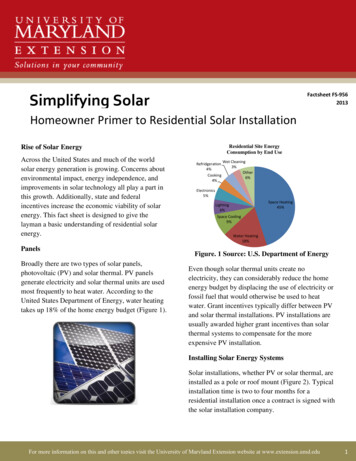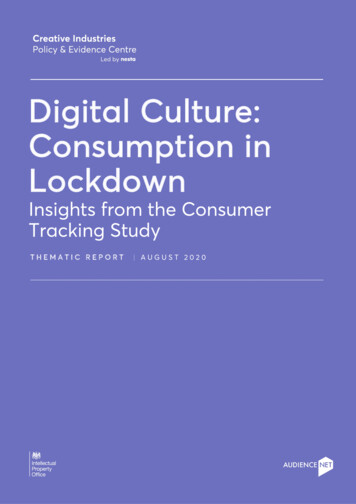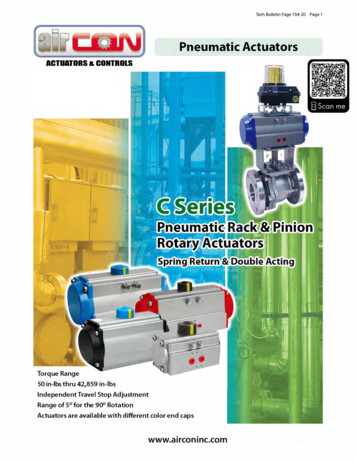
Transcription
Factsheet FS-9562013Simplifying SolarHomeowner Primer to Residential Solar InstallationRise of Solar EnergyAcross the United States and much of the worldsolar energy generation is growing. Concerns aboutenvironmental impact, energy independence, andimprovements in solar technology all play a part inthis growth. Additionally, state and federalincentives increase the economic viability of solarenergy. This fact sheet is designed to give thelayman a basic understanding of residential solarenergy.PanelsBroadly there are two types of solar panels,photovoltaic (PV) and solar thermal. PV panelsgenerate electricity and solar thermal units are usedmost frequently to heat water. According to theUnited States Department of Energy, water heatingtakes up 18% of the home energy budget (Figure 1).Residential Site EnergyConsumption by End UseRefridgeration4%Cooking4%Wet Cleaning3%Other6%Electronics5%Space Heating45%Lighting6%Space Cooling9%Water Heating18%Figure. 1 Source: U.S. Department of EnergyEven though solar thermal units create noelectricity, they can considerably reduce the homeenergy budget by displacing the use of electricity orfossil fuel that would otherwise be used to heatwater. Grant incentives typically differ between PVand solar thermal installations. PV installations areusually awarded higher grant incentives than solarthermal systems to compensate for the moreexpensive PV installation.Installing Solar Energy SystemsSolar installations, whether PV or solar thermal, areinstalled as a pole or roof mount (Figure 2). Typicalinstallation time is two to four months for aresidential installation once a contract is signed withthe solar installation company.For more information on this and other topics visit the University of Maryland Extension website at www.extension.umd.edu1
Pole MountRoof MountFigure. 2Pole Mount Installation:There are benefits and disadvantages to both poleand roof mount installations. It is relatively easy tooptimize panel location and orientation in a polemount installation. Pole mount installations are nothampered by roof space or shape. It is also easier toinstall sun tracking equipment on pole mountedsystems, although at this time most residential solarinstallations do not include tracking equipment. Aproblem with pole mount systems is they take upextra ground space, which may be less aestheticallypleasing or even cause zoning issues. Pole mountsalso tend to require more hardware which can addto the expense of installation.Roof Mount:Roof mount installations are advantageous in thatthe main part of their support structure, the house orgarage roof, is already in place. Although someadditional mounting brackets are required, roofmount installations generally require fewermaterials than pole mount installations. Roof mountsystems have the added benefit of not taking upspace in the yard or other land. However, roofmounts are disadvantaged in that a roof does notalways have sufficient usable space, the correctangle, or face in the right direction for panels toreap maximum energy from the sun. “Racking”hardware can be used to correct some of thisdirectional issue, but at an added expense.Homeowners may also face added expense whendoing roof repair on structures equipped with a solarinstallation.When choosing between pole and roof mountinstallations, consideration should be given toavailable land space, zoning regulations, ideal panelorientation and homeowner preference. Thedecision making process should also involvediscussions with solar installation professionals.Some homeowners choose to install systemsincorporating both roof and pole mountinstallations.Storing & Using Solar EnergyPhysical location of PV and solar thermal systemscan be similar. However, in terms of storing andutilizing energy these systems are vastly different.Solar Thermal:Solar thermal units store energy, in the form ofheated water, in well-insulated storage tanks (Figure3). This heating process could be the only form ofdomestic hot water heating a home has. However,due to the intermittent nature of solar energy, mostsolar thermal installations are supplemented withelectric or natural gas hot water heaters. Thoughrecreational uses are typically not funded throughgovernment grants and subsidies, solar thermalunits also provide a great way to heat swimmingpools.For more information on this and other topics visit the University of Maryland Extension website at www.extension.umd.edu2
Figure. 3Source: The Heating Business LTDPhotovoltaic:PV installations either tie into the electrical grid oruse batteries to store electrical power. Housesequipped with grid tie systems “push” electricitynot used in the home back into the electrical grid tobe used by other electricity consumers. If the gridtie PV installation has an electrical deficit, thisdeficit will be offset by the utility company. Forexample, a given residence may use 35 kWh perday. If their solar installation generates 15 kWhtheir electric meter will show only a 20 kWh dailyincrease because electricity generated by the solarinstallation offsets electric purchased. The processof tracking electrical use and generation in thisfashion is called net metering. Generally, electricityproduced beyond monthly use is carried over on amonth to month basis as a credit and electriccompanies pick a set month to resolve anyoutstanding balances. The buyback of electricity isonly available with grid tie PV installations. Listedbelow are advantages and disadvantages of grid tieand battery solar installations. Independence from electric companyOff grid systems have the following disadvantages: More expensive installation, except whenlocated far from electrical accessNeed space for battery storageBattery maintenanceIt is possible to install a smaller number of batteriesand still tie to the grid. However, due to the addedcost and complexity these installations are rare.Shading and InvertersWhen installing a PV system avoid locations wherepanels will be shaded. Even partial shading of PVinstallations has a disproportionate impact onelectrical generation. A shadow on a panel canrepresent a reduction in power over 30 times itsphysical size. Additionally, if not using microinverters, shading of one panel can disrupt electricalgeneration of multiple panels. Inverters convertdirect current (DC) electricity, generated by solarpanels, to alternating current (AC) electricitycapable of powering household devices and enteringthe electrical grid.Grid tie systems have the following advantages: Less costly to install unless location is notnear current electric sourceCan sell excess kWh’s back to providerDo not require battery maintenanceDo not require space for battery storageTraditionalinverterGrid tie systems have the following disadvantages: Does not offer independence of anelectricity providerDoes not provide power during poweroutagesOff grid systems have the following advantages: MicroinverterFigure. 3Power during power outagesFor more information on this and other topics visit the University of Maryland Extension website at www.extension.umd.edu3
Choosing between micro inverters or the traditionalinverter (Figure 3) makes a difference in solar PVperformance under partial shading and in the eventof a solar array suffering damage to a portion of itspanels. Both traditional and micro inverters are usedto convert DC current, produced by the solar panels,to AC current so the electrical power can enter thegrid. The difference is that, when using microinverters, each solar panel has its own inverter. Thetraditional inverter set up entails attaching manypanels to one inverter. Damage or shading to any ofthe panels, when using a single inverter, willnegatively affect electrical generation of all panels.Micro inverters help alleviate this problem becausethey separate performance of individual panels. Ifonly one panel out of three is shaded or damagedthe other two panels will produce as normal. Thetraditional single inverter does not afford thisbenefit. Rather, even a small amount of shading ordamage to one panel will cause the rest to performpoorly. Determining if the added cost and benefitsof micro inverters are worthwhile should be decidedon an individual basis. Shading will also reduce theproduction of solar thermal panels. However,comparatively shading does not reduce theproduction of solar thermal panels as strongly as PVpanels.Economics:Initial cost for both PV and solar thermalinstallations can be quite high. For example, theinvestment required for a grid tied PV installationsized at 8.93 kW capable of producing electricalneeds of the average Maryland family, not usingelectric as a heat source, may be in the 40,000 – 50,000 range. However, residential solarinstallation costs are offset by government subsidiesand mandates making the payback of initialinvestment much quicker (Figure 4).At the state level, as of 2013, there is a 1,000 PVgrant for Maryland residents and a 500 solarthermal grant. For current information related toPayback of Initial InvestmentYear 1Cost ofinstallationYear 2Year 3Year 4Year 5Year 6Year 7Year 8Year 9Total% ofPayback12,00030.0%1,0002.5% 40,000Benefits of InstallationFederal tax credit(30%)MarylandincentiveSRECValue ofelectricityTotal e 4* Based on 137.50 SREC sale and .11 kWh electricity, both subject to change* Individual results may vary due to changes in SREC market, price of electricity, and other factors* Typical scenario based on survey results from 35 photovoltaic installations in Washington County MarylandFor more information on this and other topics visit the University of Maryland Extension website at www.extension.umd.edu4
state incentives on renewable energy visithttp://www.dsireusa.org/ . Additionally manycompanies installing solar energy systems areknowledgeable about state and federal incentives.Owners of commissioned solar installations, bothPV and solar thermal, can also sell Solar RenewableEnergy Credits (SREC’s). The SREC marketfluctuates, but in the fall of 2012 the price perSREC is about 140. One SREC is 1,000 kWh.Homeowners can sell their SREC’s themselves.However, most find more success working througha SREC aggregator. SREC aggregators, for acommission, put together SREC’s from multiplehomeowners making a more attractive offer toutility companies.To understand what drives SREC markets, keep inmind Maryland utilities are required, by law, toproduce a certain percentage of their electricityfrom renewable sources like wind, hydro, and solarenergy. The law governing this percentage is theRenewable Portfolio Standard and it also establisheswhat portion of this renewable energy must comefrom solar energy. Rather than produce the requiredrenewable energy themselves, utilities are allowedto purchase renewable energy as “credits”. Thisestablishes the Renewable Energy Credit,commonly referred to as REC. Each REC is 1,000kWh. These credits go towards the RenewablePortfolio Standard set forth by the state ofMaryland. Solar Renewable Energy Credits arecommonly called SREC’s.As of 2012 there is also a 30% federal tax credit forresidential PV installations. Keep in mind federaltax credits are not the same as a grant. Tax creditsare monies individuals are not required to pay intaxes they otherwise would have been. For example,a 40,000 PV installation owner would be awarded 12,000 in federal tax credits. Since manyAmericans do not pay 12,000 annually in federaltaxes it is likely it will take several years, of notpaying federal income taxes, to realize the benefitsof the 12,000 federal tax credit. The example infigure 4 illustrates this by indicating 4,000 infederal tax savings per year, taking three years torealize the 12,000 federal tax credit. Consult yourtax professional to better understand how federaltax credits will or will not benefit you.Without any incentives or rebates, with currentpricing and electrical rates, payback of initialinvestment in PV would likely be 30 years.CO2 Emission AdvantageUnderstanding CO2 emissions requires looking atthe complete life cycle of an energy source, not justthe production phase of a fuel. For example,consider a gasoline powered automobile. Measuringexhaust CO2 while the motor is running would giveemission numbers, but would not account for CO2emissions during the automobile manufacturingprocess. Neither would it account for emissionsfrom gasoline production. Life cycle CO2 emissionsfor automobiles would account for manufacturing,gasoline production, operation of the automobile,and any other processes emitting CO2 associatedwith the manufacturing or operation of automobiles.Coal fired power plants likely emit 1,000 grams ofCO2 equivalent per kWh of power generation. PVlife cycle emission figures, like those for coal, needto account for mining of raw materials, like silicon,and the manufacturing process. Life cycle CO2equivalent emissions for PV likely average only 22grams of CO2 equivalent per kWh of powerproduction. During actual operation emissions fromsolar panels are negligible.For more information on this and other topics visit the University of Maryland Extension website at www.extension.umd.edu5
Conclusion:Solar installations provide varying degrees ofenergy independence, environmental benefits, andwith current financial incentives, they areeconomically viable. Still, deciding to purchase orlease a solar installation is a big decision. Use thisdocument as a guide to determine if and what typeof solar installation is right for you.In conclusion, watch for newer technologies likesun tracking equipment and thin-film technologies.Even though these technologies may not experiencea high level of application today they could in thefuture.References Department of Energy http://energy.govDSIRE, a database of State and FederalIncentives for Renewables & Efficiencyavailable at http://www.dsireusa.org/Internal Revenue Service (information onfederal tax credits) http://www.irs.govMaryland Clean Energy Centerhttp://mdcleanenergy.orgMaryland Energy Administrationhttp://energy.maryland.govU.S. Energy Information Administrationhttp://www.eia.govThis publication, Simplifying Solar - Homeowner to Primer to Residential Solar Installation (Factsheet FS-956), is a series ofpublications of the University of Maryland Extension. The information presented has met UME peer review standards, includinginternal and external technical review. Please visit http://extension.umd.edu/ to find out more about Extension programs in Maryland.The University of Maryland Extension programs are open to any person and will not discriminate against anyone because of race, age, sex, color, sexual orientation, physical or mental disability, religion,ancestry, national origin, marital status, genetic information, political affiliation, and gender identity or expression.For more information on this and other topics visit the University of Maryland Extension website at www.extension.umd.edu6
PV installations either tie into the electrical grid or use batteries to store electrical power. Houses equipped with grid tie systems "push" electricity not used in the home back into the electrical grid to be used by other electricity consumers. If the grid tie PV installation has an electrical deficit, this











